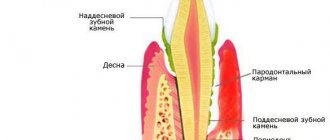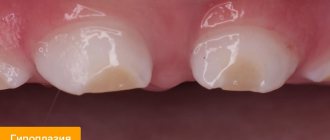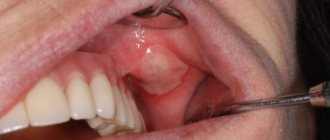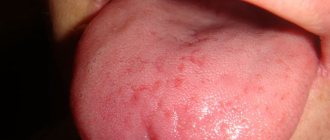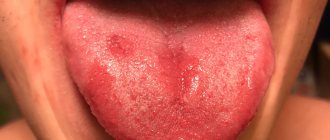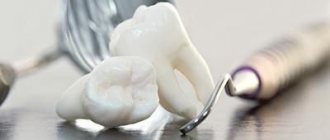Pulpitis is the inflammation of the pulp, the tissue located inside the tooth. This disease poses a fairly serious threat to the child’s body as a whole. Therefore, it should be taken as seriously as possible.
For those who doubt whether pulpitis of baby teeth occurs in general, we will answer unequivocally: it happens. And besides, it usually progresses much faster than in adults. In children, the hard dental tissues are thinner, and the dentinal tubules, on the contrary, are wider, which leads to the rapid development of infection inside the teeth. Therefore, in childhood, this disease much more often acquires a chronic form with all the ensuing consequences.
Why does pulpitis of a baby tooth occur? How to detect it? And what should parents do if this misfortune befalls their dear child?
Causes of pulpitis of primary teeth in children
Most often, according to dentists, this very unpleasant disease in childhood is caused by:
- If caries treatment is not carried out on time - in this case, microbes developing in the carious cavity and tooth tissue disintegrating under their influence provoke the active release of toxins. Under their influence, the inflammatory process of the pulp most often begins, which, if left untreated, can lead to very serious consequences.
- An acute infectious disease suffered by a child - during the course of an infection, tooth pulpitis in a child, as a rule, occurs against the background of decreased immunity and the appearance of a large number of bacteria.
- Injury to a baby tooth - this can be either an accidental damage to the tooth during play or rest, or too rough treatment of the oral cavity in the presence of caries, or even a careless action of the dentist;
- Medical errors in the treatment of caries - inflammation of the pulp can develop under the influence of incorrectly selected filling material or as a result of treating the oral cavity with too strong antiseptics, for example, alcohol, as well as due to overheating of dental tissues during the preparation of a carious cavity.
Incidence of pulpitis
Many parents do not take their children to the dentist, believing that pulpitis cannot develop in a child at 2 years old. Mothers think that if they don’t give their baby sweets, then caries won’t affect the enamel. Unfortunately, they are wrong. Tooth pulpitis can strike a child at 2, 3, or 5 years of age.
- At 2 years of age, pulpitis affects the baby's front teeth;
- From 3-4 years of age, children more often suffer from pulpitis in the back teeth. Often a 4-5 year old child comes to the dentist crying from pain in his molars. Surprisingly, such inflammations occur several times more often than pulpitis in the front teeth of children.
Preventive measures
The basis for preventing childhood pulpitis is timely and complete treatment of caries (including baby teeth). In addition, it is important:
- rinse the child’s mouth after every meal, especially sweets;
- brush your teeth twice a day using a special children's toothpaste without abrasive particles and whitening components;
- Once a month, independently examine the child’s mouth; if symptoms of pathologies are detected, consult a doctor;
Bring your child for preventive dental examinations at least 2 times a year.
What symptoms indicate pulpitis of primary teeth?
The following will help you tell if your child has pulpitis:
Complaints about toothache
As a rule, it worsens in the evening and at night, as well as during the process of chewing food. There is almost always a reaction to cold or hot drinks. Painful sensations may occur when tapping the tooth. With an exacerbation of the inflammatory process, the pain becomes aching and constant.
However, it should be borne in mind that the rapid transition of the disease into a chronic form, characteristic of childhood, often leads to the disappearance of pain. Which does not mean there is no problem. And you should visit a doctor even if the tooth stops hurting.
Cheek swelling (swelling)
This symptom can often be found in photographs of pulpitis in baby teeth. However, it is not always observed. And, in addition, it can signal diseases such as periodontitis or periostitis. But pulpitis should not be ruled out. Only a doctor can make an accurate diagnosis. And you may have to take an x-ray.
Increased body temperature and deterioration of general condition
If the child has a strong immune system, then a high temperature may also indicate the development of the disease. In this case, the body reacts to the inflammatory process that began in the pulp. And if there are no suspicions of other diseases accompanied by an increase in body temperature, be sure to show the child to the dentist.
If your baby has a toothache, or you observe any of the above symptoms, you should immediately visit a doctor. Perhaps it's time to start treating baby tooth pulpitis. In any case, there is definitely a reason to visit the dentist’s office.
Complications of pulpitis
You can, of course, endure pulpal pain by using folk remedies and modern painkillers toothache But such self-medication usually leads to the development of serious complications. Treatment of pulpitis at home is possible only in emergency cases by calling a dentist at home, who will arrive with all the equipment necessary for treatment. In other cases, treatment of pulpitis with folk remedies will not lead to anything other than complications. One of the most common complications of pulpitis is periodontitis . The infection located in the inflamed pulp slowly but surely penetrates beyond the tooth and causes inflammation of the tissues surrounding the tooth root - periodontitis develops. Periodontitis is dangerous because with this disease there is a gradual destruction of bone tissue near the roots of the tooth. In chronic periodontitis, the formation of granulomas, cystogranulomas and perihilar cysts often occurs . Such chronic foci of inflammation respond very poorly to therapeutic treatment and often lead to the removal of the diseased tooth. In addition, these chronic inflammatory foci cause the spread of infection through the bloodstream throughout the body, which can provoke chronic diseases of the internal organs of a person.
How to treat pulpitis of baby teeth
If you suspect that your son or daughter is suffering from this particular illness, then the best thing to do is to seek professional help as soon as possible. Because the disease is quite serious, and it requires correct diagnosis and qualified medical intervention.
There is no need to remove the tooth at all. Moreover, early removal can lead to the formation of an incorrect bite. The course of treatment of pulpitis in children largely depends on the stage of tooth development at which it is detected.
The fact is that the pulp can be completely removed only in the formed roots (and this takes several years from the moment the tooth erupts). Therefore, in most cases, the doctor removes the pulp only partially. As a rule, carious lesions are removed simultaneously with its part located in the crown of the tooth. This procedure is carried out after an anesthetic injection. After that, a medicine is placed at the bottom of the cavity and at the mouths of the canals, designed to disinfect the remaining tissues. Or, the pulp is first mummified, also through the application of drugs, and then removed.
Over time, such a “gasket” of medications is replaced or left under a permanent filling.
In case of pulpitis of milk teeth, first of all, it is necessary to eliminate the inflammatory process and prevent complications in the form of periodontal damage, which can cause improper formation of permanent teeth. There are 3 main methods in total.
Frequently Asked Questions About Nerve Removal
The news that a child needs to “remove a nerve in a tooth” often frightens parents, and they ask quite reasonable questions. Below are answers to the most popular ones.
1. How much does it hurt?
In modern medicine, tooth depulpation is always performed under local anesthesia, so the child will not experience any pain. And even if you are allergic to anesthetics, you can choose a treatment method with minimal discomfort for him.
2. Is it possible to somehow save the pulp?
This is usually the first thing parents ask when they hear about the need to depulp a tooth. Believe me, the dentists of the Natadent clinic will never perform tooth depulpation if there is no indication for this. And if the doctor has chosen this treatment option, it means that in this situation this is the best choice, because first of all we must take care of the germ of a permanent tooth, which can be damaged if the infection spreads.
3. Will treatment of pulpitis affect permanent pulpitis?
The pulp of the baby tooth and the permanent tooth are not connected in any way. The main thing is that the first one stays in his place for the entire time allotted to him. After treatment of pulpitis of a baby tooth, there will be no consequences for the permanent tooth; it will grow up completely healthy. In addition, timely treatment of pulpitis of a baby tooth prevents the spread of infection to the permanent tooth and keeps it healthy and strong.
4. Is it true that a pulpless tooth quickly decays?
Many parents are sure that “a tooth without a nerve does not live long.” This is an erroneous judgment. The service life of a pulpless tooth depends only on the quality of treatment and the materials used. Thanks to modern technologies and materials, teeth after nerve removal last a long time and look no worse than their neighbors.
5. What could be the consequences?
As noted above, modern technologies provide a pulpless tooth with a long service life. When treating pulpitis of primary teeth with older methods, the main consequences were discoloration and a decrease in the strength of the tooth.
After quality treatment at the Natadent clinic, such problems will not arise. But keep in mind that a pulpless tooth requires more careful care. The reason is that the pulp is an important source of mineralization of the enamel. Therefore, to preserve the strength and color of the tooth, it is recommended to use fluoride-containing toothpastes and promptly carry out fluoridation. We also recommend coming for follow-up examinations once every three months, during which the filling is polished and corrected for longer service.
6. How many visits will be required?
In modern pediatric dentistry, the treatment time for pulpitis is minimized to maintain maximum comfort for young patients. As a rule, the procedure takes about 40 minutes and is carried out at one time, but if there is a more complex clinical situation that requires a different approach, the number of visits can increase up to 2 times with an interval of a week. This approach to treatment may be associated with the presence of an acute or advanced infectious process, which may require a longer stay of the medicinal drug in the tooth. In this case, on the first visit, under anesthesia, we put a special anti-inflammatory drug with an antibacterial effect into the tooth and close the cavity with a temporary filling, and on the second visit, if there is positive dynamics, we finally fill the tooth with a modern composite material.
In situations where it is impossible to immediately remove the nerve (for example, a child is allergic to anesthetics), the traditional method with pulp devitalization is used, but instead of arsenic, more modern drugs are used. This method will require 2 visits approximately a week apart.
Biological method of treating pulpitis in children
Several years ago, dentists began to practice conservative methods of treating pulpitis in children. This conservative therapy does not require surgical intervention, is easier for the baby to tolerate and causes minimal complications.
Conservative treatment of pulpitis of primary teeth is carried out in stages:
- The doctor opens the inflamed cavity.
- Covers the bottom of the gum and pulp with a special mixture consisting of Shostakovsky balm, calcemin and artificial dentin.
- After the mixture dries, the dentist seals the tooth using fluorine cement or phosphate cement spacers.
Doctors are ambivalent about such a procedure. Some consider biological treatment of pulpitis in children to be an excellent way to relieve the child of pain and create the most favorable conditions for the development of the apices of the roots of permanent teeth.
Many dentists believe that it is the conservative method of treating pulpitis of baby teeth that can provoke various periodontal inflammations.
In any case, treatment of pulpitis of primary teeth requires repeated visits to the doctor and a serious approach. Therefore, be persistent and patient, and also try to set up your child correctly so that every trip to the clinic does not become stressful.
Please note that there is no general approach here. The inflammatory process occurs differently each time. And only a doctor can decide how to treat pulpitis of a baby tooth in each specific case.
Why is it better to treat pulpitis in a child at the Stokos clinic?
Stokos dentistry in St. Petersburg is the place where your child’s smile is born. In the hands of our doctors, the most valuable thing is the health of children, so we work tirelessly to ensure that little patients feel comfortable and calm with us. Parents trust Stokos and are always confident in a high-quality result without the chance of disappointment. The following helped us achieve a decent level of treatment for pulpitis and other dental pathologies:
- expertise of doctors. We are not just “certified specialists”, we go about our business with a sincere intention to help, we always achieve our goals;
- quality materials and advanced equipment. These two components are the key to comfortable, fast, safe and effective treatment of children’s teeth;
- pleasant atmosphere, ease of communication. It’s easy with us - we are friendly, smiling, we don’t waste time, we don’t make our patients wait, we will find a common language with any child;
- reasonable prices. Treatment of pulpitis in baby teeth at a price that won’t scare you – it’s possible. We try to make dental care accessible to almost everyone - we set affordable prices for services.
Make an appointment with our pediatric dentist - in the case of children's teeth, every minute is worth its weight in gold!
Possible mistakes when treating pulpitis
Unfortunately, it is not at first glance that tooth pulpitis in a child is a simple ailment. Incorrect treatment can provoke nightmares such as periodontitis, periostitis and even acute polio.
The most common mistakes when treating pulpitis in children are:
- Incorrect assessment of the condition of the pulp and, consequently, partial removal of inflammation. In this case, the baby will very soon suffer from a new exacerbation.
- Loose bandage when removing pulp. In rare cases, doctors do not apply a temporary bandage with arsenic tightly enough, which can lead to burns and necrosis of the tissues of the cheek, tongue and mucous membranes.
- An overdose of arsenic can cause acute periodontitis, which requires longer treatment than pulpitis in a child.
- Trauma to the periodontium with a root needle. Incomplete cleaning of root canals during the treatment of acute or chronic pulpitis in children can also provoke periodontitis.
Treatment of pulpitis: how to adjust a child
Pulpitis of baby teeth causes a lot of trouble for the baby. There is no need to aggravate the already difficult days of the child; parents should definitely prepare him for a visit to the dentist.
Talk to the baby. Explain that the doctor will treat tooth pulpitis carefully and the patient will not feel pain. It is important that the child does not associate going to the dentist with torture chambers. Choose a positive doctor whom you trust, and dental treatment will become an exciting attraction.
The main task of parents is not to let the disease take its course. Since chronic pulpitis of the baby tooth, which is most often seen in the photo, can lead to further spread of the inflammatory process and damage to the rudiments of permanent teeth.
And don’t forget that preventing trouble is always easier. Therefore, do not allow pulpitis. Ensure that your child brushes their teeth correctly and regularly using high-quality oral hygiene products. And be sure to visit your dentist regularly.
ASEPTA BABY toothpaste for babies from 0 to 3 years old will help you quickly teach your baby to brush their teeth. The soft gel carefully cares for your teeth, reliably protecting them from caries. And the sweet taste of tutti-frutti makes the procedure pleasant and tasty.
Classification of childhood pulpitis
Acute pulpitis comes in two subtypes:
- focal pulpitis (partial);
- diffuse pulpitis (general).
Chronic pulpitis has more varieties:
- Gangrenous pulpitis
This form of pulpitis is a direct consequence of an acute diffuse inflammatory process that developed from a focal one. The tooth enamel noticeably darkens, but no pain is observed. During the examination, the doctor reveals a characteristic putrefactive odor, which indicates the presence of a pathogenic process. A fistula forms at the top of the gum next to the damaged tooth.
- Fibrous pulpitis
This subtype is characterized by periodic aching pain that occurs during eating and continues after completion.
- Hypertrophic pulpitis
The main signs of this type of pulpitis are: destruction of the tooth crown, absence of pain (maximum discomfort during chewing). Pain occurs during probing of the tooth and when exposed to various irritants (temperature, chemical, mechanical).
Pulpitis of permanent teeth in children
Pulpitis of permanent teeth in children is a common ailment among adolescents. Surprisingly, newly erupted molars are especially sensitive to external influences, because during the first few years they are not yet saturated with mineral components.
Pulpitis of permanent teeth in children most often develops against the background of deep or medium caries. And if in children with formed tooth roots, pulpitis develops in the same way as in adults, then in adolescents with just developing roots, this ailment is significantly different from what is usual for parents.
Symptoms of pulpitis of permanent teeth in children
Acute pulpitis
Features of pulpitis in permanent teeth with incomplete growth include:
- Spontaneous pain. Children complain of unexpected, mild pain in the mouth. Unpleasant sensations arise suddenly, for no apparent reason. The pain can torment a teenager for hours, or it can go away on its own in 15-20 minutes. Often, various irritants, such as cold or hot food, cause discomfort.
- With acute diffuse pulpitis of permanent teeth in children, discomfort intensifies in the evening and at night. Soon the pain becomes constant, radiating to the temple, back of the head, ear or infraorbital area. Very soon, painkillers become ineffective.
- Softened dentin of the carious cavity, weakly pigmented, also indicates tooth pulpitis.
- Acute throbbing pain radiating to the trigeminal nerve is also a symptom of acute purulent pulpitis with incomplete root formation. It is noteworthy that the pain intensifies when consuming hot food or drinks and is relieved by cold food.
Chronic pulpitis
Chronic pulpitis of permanent teeth with unfinished growth, as in baby teeth, can occur as a primary process without an acute stage. The following symptoms are characteristic of chronic inflammation:
- Aching spontaneous pain;
- Unpleasant sensations when eating or pressing on a tooth;
- Prolonged pain from cold or hot food;
- Pulp bleeding.
Chronic gangrenous or fibrous pulpitis of permanent teeth in children can occur in both open and exposed pulp chambers. Fibrous inflammation is characterized by a dark red chamber that bleeds unpleasantly when touched. Gangrenous pulpitis is usually accompanied by gray-green discharge with a putrid odor.
Chronic pulpitis in children goes away sluggishly, the pain returns every now and then. A teenager complains of attacks of pain spreading along the trigeminal nerve.
Treatment of pulpitis of permanent teeth in children
Doctors distinguish two methods of treating pulpitis in permanent teeth. At the discretion of the doctor, therapy is carried out with partial or complete preservation or removal of the pulp. Let's look at each method in more detail.
Conservative treatment
“A living tooth has a better chance of survival than a dead one” - you’ve probably heard this common and, of course, fair phrase. Recently, dentists have mastered the biological method of treating pulpitis of permanent teeth in children, which is recommended for diseases such as:
- Pulp hyperemia;
- Traumatic pulpitis;
- Acute serous pulpitis;
- Chronic fibrous pulpitis without destruction of periodontal tissue;
- Acute pulpitis, lasting no more than a day;
Unfortunately, science has not yet moved that far forward, and biological treatment of pulpitis is effective when the child is in good condition and has a shallow carious cavity.
For adolescents with incomplete root formation, dentists treat pulpitis using the method of partial nerve preservation. This method helps complete the formation of the root system.
Pulpitis of primary and permanent teeth: how to recognize acute and chronic disease
Pulpitis of “milk jugs” and molars in children progresses in acute or chronic form. An acute process in a child is uncommon. It can be purulent and serous.
In the serous form, inflammation of the pulp is accompanied by filling of the dental canals with a specific substance. The child suffers from pain, which intensifies when chewing and at night. The pain is usually one-time. Within a few hours the disease takes on a purulent form.
At this stage, the fluid turns into pus. The nature of the symptoms is determined by the child’s immunity, the activity of pathogens, and the condition of the tooth roots. There may be no pain if the little patient’s immune defense is strong, the bacteria in the tooth are inactive and the purulent contents flow out through the carious cavity. More often the pain is severe, prolonged, and sometimes spreads to other teeth. The child cannot touch the tooth, his body temperature rises, and the cervical lymph nodes enlarge.
Chronic pulpitis is often asymptomatic and can affect deeply “neglected” teeth or progress under fillings. Unexpressed pain may bother the child when chewing food, contact with cold foods and drinks.
In addition to traditional forms of pulpitis in children, there are:
- fibrous. The connective pulp tissue grows and extends beyond the carious cavity. Sharp pain begins to bother the child after eating and lasts for several hours. This is an intermediate stage between acute and chronic pathology;
- hypertrophic. A rare “guest” of a child’s mouth. The disease occurs against the background of advanced chronic inflammation. There is no crown of the tooth, there is no pain, when probing the pulp begins to bleed;
- gangrenous. Late stage. The local element darkens, the pulp is destroyed - bad breath appears. A fistula with pus forms on the gum. The pain is subtle or absent at all.
